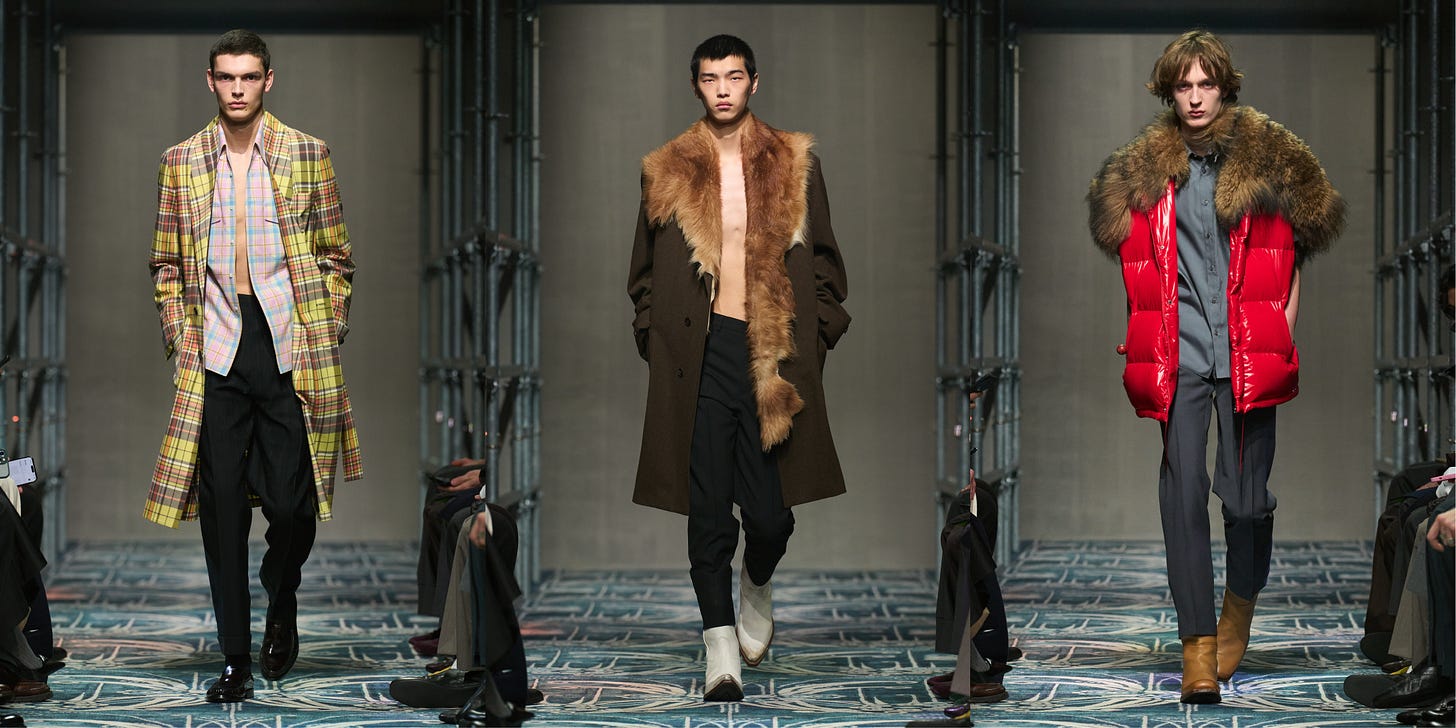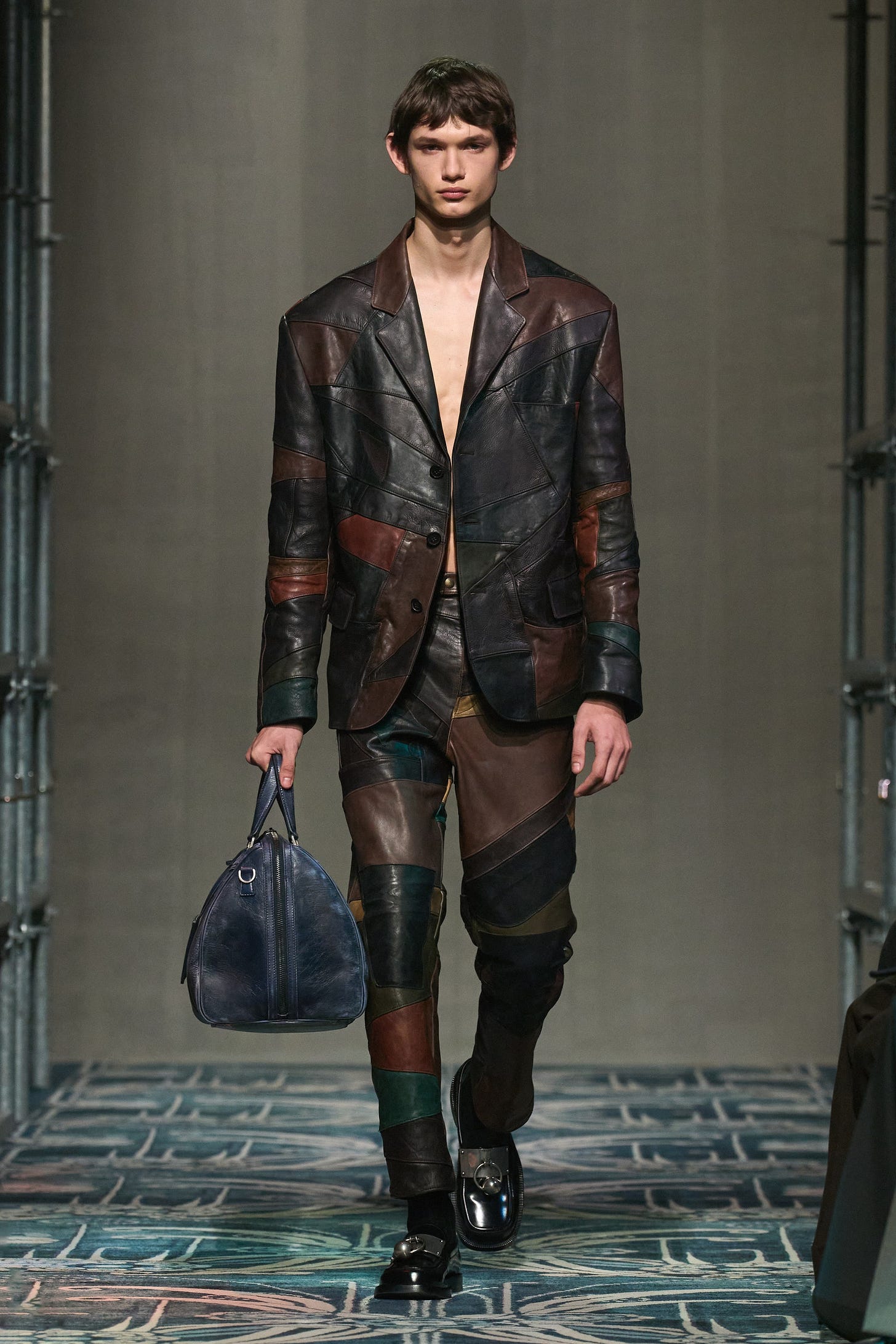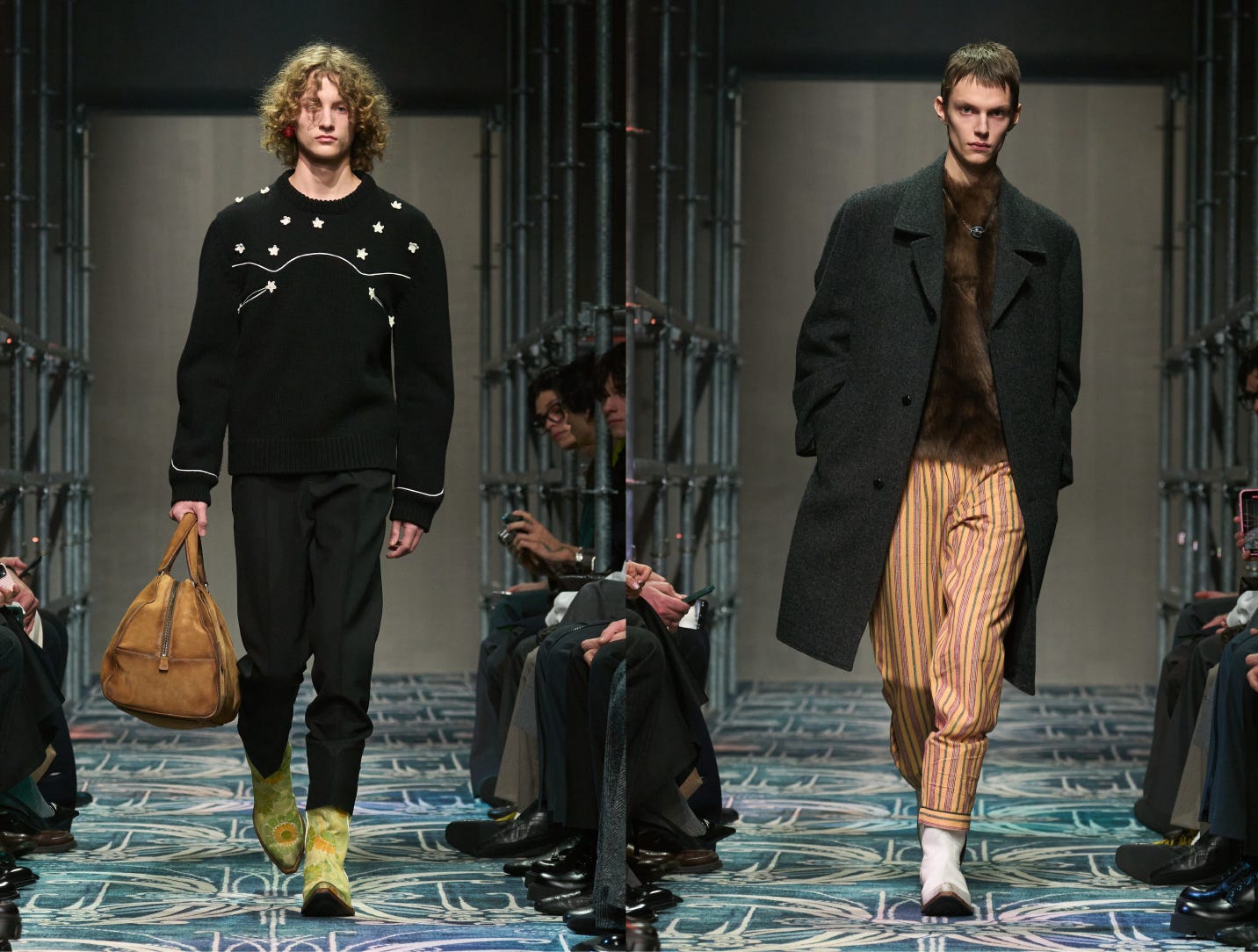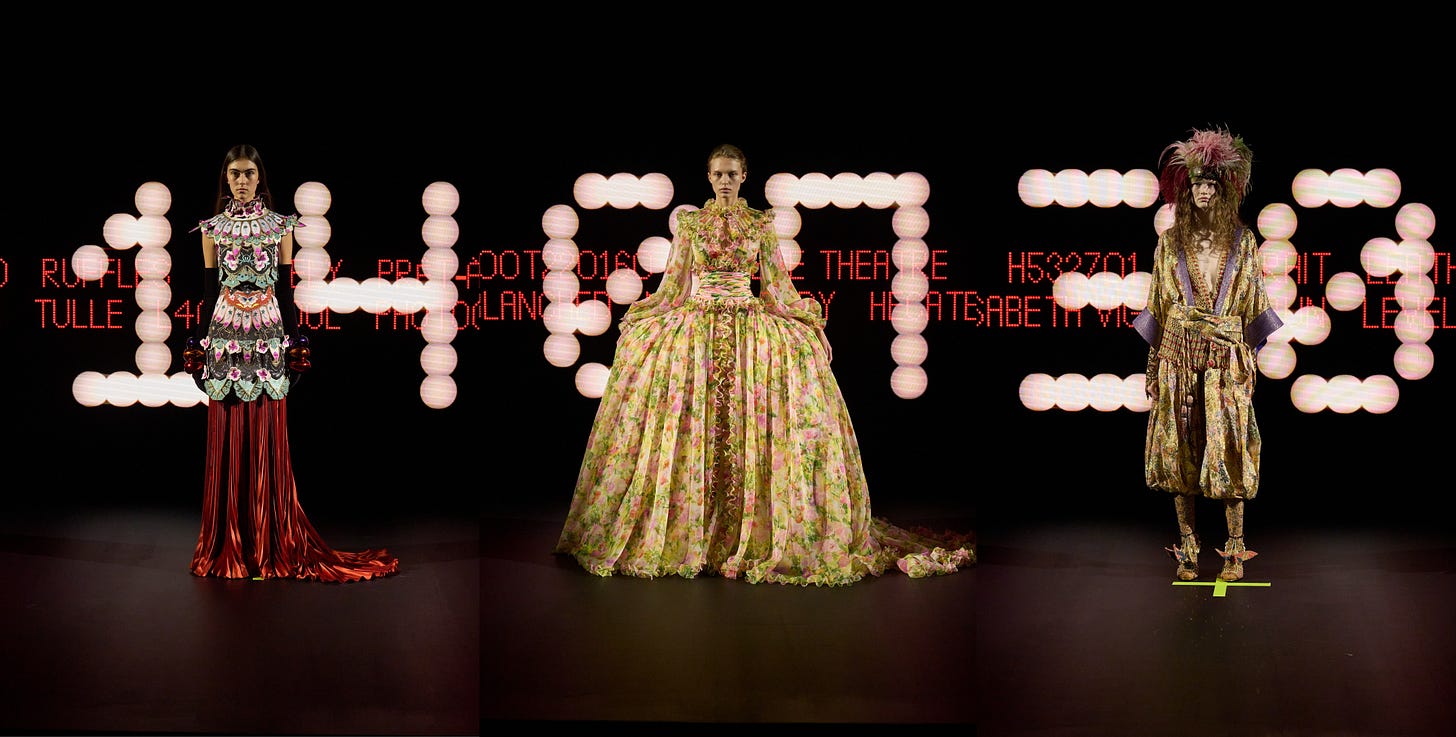Does Anything Have To Mean Anything?
Wrestling with a Prada Menswear of Vibes and a Maximalist Valentino
I think it’s strange that Menswear fashion weeks start off the year. To follow them immediately with couture weeks has the effect of equating the two as equally niche, equally dusty, if not placing menswear as always lesser than couture extravagance. Either way, in an industry where brands could easily host 8-10 shows a year, men’s fall/winter is rarely chosen as a moment for big swings and risks.
In my now distant memories of the week, Prada FW25 Menswear remains a source of frustration and fascination, where intellect was justified through passionate impulse. A sense of randomness, clashing colors and textures, and warped fits abounded. Some defined the show through “clubwear, Americana, or shirtless waify men with tidy haircuts. I believe Miuccia Prada when she speaks about the show, held on the same day of Trump’s inauguration, as a response via “our instinct, our humanity, and our passion.“ I believe Raf Simons when he says looks and pieces were actually simply chosen based on what “felt right,” none of these cultural contexts but instead a “non-system“. I believe him because even when employing more concretely articulated thematics, Simons has been attracted to club rat twinks in New Wave Western wear for his entire career. In this refusal to define the terms or context of Prada’s classical interplay between strange and ugly beauty, Prada and Simons become subservient to the “vibe.”
This focus on aestheticizing “impulse“ over concrete concepts allows Prada to get away with what others cannot. The floral print on a jagged boot emerges from the spontaneous ether, not because Loewe made a similar, popular boot the season before. Fur was just trendy, controversial, so its random placement as jagged collar and sleeveless top is proposed as an empty signifier - do not assign it to context, do not question how it is made, why it was made. Why ignore the potential of politics to patchwork, especially in leather sets that evoke a polished hippy while likely costing four figures each? How does Prada retain an air of intelligence while skirting the consideration and politics of its garments? Where is the necessity? What fantasy, concept, justifies these garments?
Prada did this last season too - justifying the oddball styling of brightly colored basics as a “human proposition” to the algorithm. A show that set out to defy traditional, computer assisted senses of normal with pure impulse. The menswear show before that was similarly described by Prada: “We just put things together.” The idea seems to be that an intangible “human-ness” defines these shows, and elevates the garments from being more than. There’s an implied defeatism here, that the complex stories and concepts that define a fashion show can somehow be repeated just as easily by an algorithm.
Further cementing this shift in priorities, Rian Phin reports Derek Blassburg speaking at a New York screening of the show saying the team spends months discussing the themes of the show, and sometimes a manner of weeks producing it.
Considering we’re three seasons deep into these human-as-algorithm feel-it-out thematics, this concept seems tired. Isn’t it important that the piece Prada sells has been designed exceptionally to reflect its dizzying price, and situated in a context and fantasy to entice? When Prada raises its prices and acts with such flagrancy it’s because they feel they’ve cultivated an audience who believes Prada offers them something “more”. The way in which Prada proves and preens what that “more” actually is has required less and less.
Admitting these garments are defined more by philosophy than by development and burying the content of that philosophy entirely leaves an algorithm that might as well be AI. After all, one of the easiest things AI can do is impulsively and randomly mix patterns, textures, and gendered garments to create a sense of individuality.
I’ll buy that there’s an essential human nuance to dictating these specifics, but isn’t a criticism of algorithmic curation only half the issue? The algorithm has done more than dilute taste, it has created a constant noise, a breakneck speed and expectation for artistic production, an inability to focus on or sit with anything. Amidst its platitudes about humanizing dress, does Prada want to escape the noise?
Olivia Kan-Sperling wrote recently in Viscose Journal about the way Prada campaigns aestheticize critical theory through meaningless text - a way of branding Prada as a source of critical thought that is in actuality, all branding. Kan-Sperling notes the shallowness of this practice while also wondering what can be understood by taking Prada’s theory-babble campaign texts “on their own terms,“ and wondering “what they teach us to desire.” Her answer is that while some designers transpose theoretical texts into clothing in wild, literal, and shallow displays, Prada’s focus is in the love of form, sentence construction over content, the specificity of fabric and cut rather than context.
What this text—and all the acronymic expansions; empty signifiers we have encountered thus far—do betray is a love for writing in its purest form; for words in themselves, divorced from the information they might convey; for the texture of ideas; for the style of theory and the surface of its language.
Later she writes that
By accessorizing, rather than merely explaining, fashion, its texts elevate both
clothing and writing to the status of fetish object. The point of language isn’t merely to mean something, just as the point of a purse isn’t only to carry your keys—or to signal the wealth indexed by the logo stamped into its leather.”
In a world in which fewer and fewer read, I agree that style is important. As fashion grows commodified to new heights, I agree that experimenting with and thinking differently about garments is important. However, I think it is possible that thinking about empty, stylized theory as a way of drawing parallels between the love of language and garment style may be mostly in service of “signal[ing] wealth indexed by the logo.“ Prada is easily as gauchely logo heavy as any modern Gucci or Balenciaga - going into a Prada store and finding something logoless is almost as impossible as affording the clothing in the first place.
What happens when the intellectual air is defined by FW25’s romantic lack of articulation? Who benefits from the consciousness that vibe and surface will triumph over concrete language?
Art that outright rejects substance or nuance in favor of glassy eyed aesthetics are, if anything, a mirror for passive viewing, uncritical questioning of consumption, and disconnected from reality. By embracing style and the inarticulate, Prada can have its cake and eat it too, existing as intellectual and logo heavy luxury symbol. Prada wants the overpriced logomaniacal basics it sells to imply the same sophistication its runway pieces do, it wants to be a special kind of logo. It isn’t.
What is clear is that a philosophy of vibes and surfaces is as anti intellectual as International Art English (the original aestheticized & empty theory babble) is exclusionary.
Kan-Sperling wrote about Alessandro Michele’s Gucci as a contrast to Prada, and an example of more literal, context driven theory intellectual signaling. Whereas Prada shows experiment with materials, contexts, and juxtapositions through style and implication, Michele hosts hundred look runways dedicated to Foucault and Donna Harraway. He invents new logos, disparate contexts, endless bricolage. For this reason, Michele’s Valentino Couture show a few days after the Prada show served as an interesting intertext, especially considering its comparatively mixed response.
Michele’s runway show involved a recurring hoop skirt silhouette, royal, gigantic, and unwieldy. Each of these dresses came in different maximalist iterations, some hand embroidered with jewels, others composed of traditional American quilted patchwork, others in brightly colored panels of mohair. Otherwise, there were archive Valentino silhouettes alongside acres of frill, and embroidery. Where Prada had a runway set of dark and steely bars evoking the club, Valentino showed these royal wares behind a giant screen with red flashing text and strobe lights. Many models wore masks, some were tight bejeweled wrestling hoods, others held chandelier-like crystals that swung before the models’ faces. The juxtaposition was of old adornment and techno maximalism, the old world adorned masks serving as the bridge between patrician wealth and android couture.
Titled “Vertigineux,” Michele’s show was inspired by Umberto Ecco’s description of the “vertigo of the list.” Lists of words appeared in the screen behind models, guests received 200 pages of show notes, endless adornments, clashing worlds, a chaos of concepts. Noise. The maximalism of lists is what defines this show as a “contemplation” of chaos. Sound familiar?
Prada and Valentino approach the algorithm with some near identical motifs - plasticy printed florals, patchwork, seemingly random juxtapositions of clothing from different eras. Prada’s recipe is defined by unconscious passion, Michele’s by dizzying concrete references and tactility. It is unclear if either show arrives at any developed sense of “content“ behind its style. However, Michele’s style is rooted in references which can be explored and extrapolated - one could google phrases and concepts like “Umberto Ecco“ or “Madame Butterfly“ - while creating something category-less and niche. Prada simply begins and ends with empty gestures.
Here though, using maximalism as an exploration of humanity amid digital chaos was unwelcome. Vanessa Friedman said of the show, “if you think that looks like an unpleasant viewing experience, you would be right.” And went on to chastise the couture show’s unwearability and disconnect from reality by claiming Michele is “Mistaking Costumes for Clothes.” Many followed with a similar refrain, loving the clothes, hating the set design.
Perhaps there is the obviousness to it all, perhaps it’s the idea that you must read to gain insight into work that has taken hundreds of hands and thousands of hours to create. Couture must be special, show stopping, fantastical, but coldly practical and quickly consumable. Is something a costume if it is worn as fashion? Should couture strive for the “pleasant?“ These criticisms of Michele’s work are bizarre to me. Why create a gown that can be worn in incredibly specific situations and only purchased for exorbitant sums of cash? I don’t know, doesn’t fashion exist to ask that question?
The mediums of the show note, the gallery description, and the movie poster blurb all seek to use language to define artistic experiences that by definition, cannot be simplified into language. They are experiments, subjectives poised to masquerade as fact, all of it advertising. For this reason many, like David Lynch or Rei Kawakubo completely avoid language to describe their work, or use the broadest terms available.
Prada’s focus on impulse and randomness define these garments and their styling exactly - there are few deeper layers. For Michele, endless sources and references may leave the viewer/wearer cold, uninspired despite everything. The root of these show notes, posturing quotations, and extravagant displays will always be physical clothes to be bought, sold, worn, and maybe kept. In spite of the noise there will be glimmers of beautiful work that rise above - a perfect Prada bag, a bug eyed crystal Valentino mask.
Thoughtlessness, hypocrisy, and algorithmic subservience are what can taint these beautiful clothes. How to ensure such special work is not simply consumed?










